The Chemical Wedding of a Martinist
In the 1960s Allen Ginsberg (pictured ) and Timothy Leary set out to prove that the use of LSD could transform the limited vision of reality prevailing in modern society.  Their modern crusade had its origins a decade earlier, in 1953 when Aldous Huxley (pictured, below right) had experimented with a reduction of the Peyote cactus, an ancient Mesoamerican hallucinogen containing high levels of mescaline. At the time Huxley was 59 years old. In The Doors of Perception Huxley wrote that the brain and nervous system are not the source of the genitive process “but rather a screening mechanism or ‘reducing valve' that transmits but a tiny fraction of the ‘mind at large'”. Huxley's experimentation with mescaline had this much in common with Leary's and Ginsberg's advocacy of LSD: both drugs altered perceptions of ordinary reality in a way that was similar to recorded mystical experiences. Indeed, mescaline, LSD and natural psilocybin have been used (as with DMT) in research into ESP and other phenomena ever since. While tackling my ‘follow-up' read of Huxley's The Perennial Philosophy, I began to reflect on what he meant by self-knowledge being “realized as an immediate, intuitive experience and appropriately acted upon” (my emphasis). In contrast, I was aware of what Evelyn Underhill (pictured, below left) had warned of when she wrote “there is to be no
Their modern crusade had its origins a decade earlier, in 1953 when Aldous Huxley (pictured, below right) had experimented with a reduction of the Peyote cactus, an ancient Mesoamerican hallucinogen containing high levels of mescaline. At the time Huxley was 59 years old. In The Doors of Perception Huxley wrote that the brain and nervous system are not the source of the genitive process “but rather a screening mechanism or ‘reducing valve' that transmits but a tiny fraction of the ‘mind at large'”. Huxley's experimentation with mescaline had this much in common with Leary's and Ginsberg's advocacy of LSD: both drugs altered perceptions of ordinary reality in a way that was similar to recorded mystical experiences. Indeed, mescaline, LSD and natural psilocybin have been used (as with DMT) in research into ESP and other phenomena ever since. While tackling my ‘follow-up' read of Huxley's The Perennial Philosophy, I began to reflect on what he meant by self-knowledge being “realized as an immediate, intuitive experience and appropriately acted upon” (my emphasis). In contrast, I was aware of what Evelyn Underhill (pictured, below left) had warned of when she wrote “there is to be no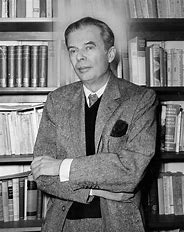 wilful choosing of method for the Man of Desire, since the greatest writers on mysticism are unanimous in their dislike and distrust of all visionary and auditive experience.” Yet Underhill had also said that anyone “who seeks the divine Cloud of Unknowing is to be surrendered to the direction of his deeper mind, his transcendental consciousness: that ‘spark of the soul' which is in touch with eternal realities.” While I do not regard myself as a mystic - or at least someone who has made much discernible progress with mysticism - it seemed to me that for any man of desire those two corresponding paths described by Underhill must inevitably coincide at some point.
wilful choosing of method for the Man of Desire, since the greatest writers on mysticism are unanimous in their dislike and distrust of all visionary and auditive experience.” Yet Underhill had also said that anyone “who seeks the divine Cloud of Unknowing is to be surrendered to the direction of his deeper mind, his transcendental consciousness: that ‘spark of the soul' which is in touch with eternal realities.” While I do not regard myself as a mystic - or at least someone who has made much discernible progress with mysticism - it seemed to me that for any man of desire those two corresponding paths described by Underhill must inevitably coincide at some point.
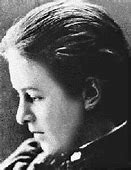 I selected a San Pedro cactus reduction as the vehicle for my own research. The San Pedro, like Peyote, the Peruvian Torch cactus and others, has a high psychedelic alkaloid content that occurs naturally, known as mescaline. The drug is in the phenethylamine class, known for its hallucinogenic effects comparable to LSD and psilocybin (magic mushrooms). It also happens to be a banned Class A drug in most western countries, for reasons that are not terribly clear, which Timothy Leary had well stated views on. However, in the United Kingdom the San Pedro cactus can be sold and purchased legally and is not difficult to acquire. Indeed, I have managed to purchase a Bolivian Torch cactus at my local garden centre, which is held by Native Bolivians to contain a much higher dose of the psychedelic compound mescaline than any other hallucinogenic cacti. That specimen however was far too small, and a much larger plant was required.
I selected a San Pedro cactus reduction as the vehicle for my own research. The San Pedro, like Peyote, the Peruvian Torch cactus and others, has a high psychedelic alkaloid content that occurs naturally, known as mescaline. The drug is in the phenethylamine class, known for its hallucinogenic effects comparable to LSD and psilocybin (magic mushrooms). It also happens to be a banned Class A drug in most western countries, for reasons that are not terribly clear, which Timothy Leary had well stated views on. However, in the United Kingdom the San Pedro cactus can be sold and purchased legally and is not difficult to acquire. Indeed, I have managed to purchase a Bolivian Torch cactus at my local garden centre, which is held by Native Bolivians to contain a much higher dose of the psychedelic compound mescaline than any other hallucinogenic cacti. That specimen however was far too small, and a much larger plant was required.
The revolting taste and texture of the San Pedro reduction cannot be overstated. It is part of the plant's natural defence mechanism from insects, and hence the high psychedelic alkaloid content. Underhill would have been relieved that I experienced no visual or auditory phenomena, unlike my dalliances with LSD and LSA. With the mescaline ingestion I was gradually, but quite powerfully, overwhelmed with what I can only describe as raw, primal emotion. I cannot explain this very well in writing, because I was taken on a journey to my core self. I was presented, emotionally, as I say, with the sensation of being in the very presence of the Christ himself.
How this remarkable minor mystical union arose, I have absolutely no idea. However ermpathogens or entactogens like mescaline are a class of psychoactive drug that produce experiences of emotional communion, oneness, relatedness and emotional openness. Entactogens are sometimes incorrectly referred to as hallucinogens or stimulants, although many exhibit psychedelic or stimulant properties as well. William James (pictured) provides a useful four-fold criteria of mystical experiences of this nature, namely:
- passive – a feeling of being subject to a superior power not under our control:
- ineffable – that there is no adequate way to describe it;
- noetic – that universal truths are revealed which cannot be acquired anywhere else; and
- transient – that the experience is temporary.
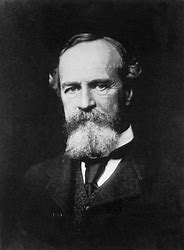 Mirroring these, in my experience I was transported, emotionally, to the arrest of Christ in Gethsemane. This was at once a passive, ineffable, noetic and transient experience that is quite incommunicable. Again - and I must emphasise - although there were no visions or auditory phenomena, I felt I was actually there in real time and space. The point I need to convey is the immediacy of the sufferings of Christ and the overwhelming sense of injustice that took place.
Mirroring these, in my experience I was transported, emotionally, to the arrest of Christ in Gethsemane. This was at once a passive, ineffable, noetic and transient experience that is quite incommunicable. Again - and I must emphasise - although there were no visions or auditory phenomena, I felt I was actually there in real time and space. The point I need to convey is the immediacy of the sufferings of Christ and the overwhelming sense of injustice that took place.
Somehow, the space between me and the object of my experience had dissolved. I was rapidly drawn into the events that had taken place such a long time ago but with direct immediacy. The space I occupied unfolded around me, and I found myself reaching out, and pleading only to be left in Christ's presence. It is quite impossible to properly convey this, but Blake's words “to see the world in a grain of sand, and to see heaven in a wild flower, hold infinity in the palm of your hands, and eternity in an hour” come closest.
The explanation I offer has to do with the present condition in which humanity finds itself. As a Martinist I inevitably draw on my own cosmogony to make sense of the experience. Louis Claude de Saint-Martin (pictured below ) wrote that through Christ we are each enabled to fulfil - as far as possible on earth - the task of regeneration. Regeneration in the Martinist sense, is an inverse evolution, where we evolve back to the point of our origin, and reunion with God. Saint-Martin uses the analogy of the “a divine seed” to clarify the process of our reintegration with omneity. As we are composite beings, the spiritual realms are said to select diverse substances to support and nourish our 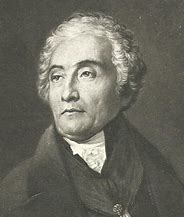 growth (Le Ministere de l'Homme-Esprit). It is in this sense that Saint-Martin saw humanity as “an exotic plant of the material universe”, evolving yet at the same time de-evolving back to the higher spiritual beings we once were. In our true nature we do not belong to the earth, which is merely our place of “encampment.” Therefore, if our true nature is an emanation of the Divine, or at least a spiritual substance, God can only be found from within and to him we must, inevitably, return.
growth (Le Ministere de l'Homme-Esprit). It is in this sense that Saint-Martin saw humanity as “an exotic plant of the material universe”, evolving yet at the same time de-evolving back to the higher spiritual beings we once were. In our true nature we do not belong to the earth, which is merely our place of “encampment.” Therefore, if our true nature is an emanation of the Divine, or at least a spiritual substance, God can only be found from within and to him we must, inevitably, return.
I can identify with this, in the sense that what I experienced on mescaline was not supernatural, but indeed very natural. I have variously experienced visual and auditory occurrences in the past. Some of them less than pleasant. However, unlike those, mescaline provided me a much deeper or noetic insight into myself, and therein lay the difference between the spontaneous phenomena in my life and what was happening now. It also triggered an overwhelming sense of my paternal instinct, which felt to be very much a part of some two-way flow of consciousness emanating to and from the Divine. Indeed, it was as if these dual aspects of fatherly love were a part of the very being of God himself, streaming into and from me, unconditionally and without any strings attached. This, perhaps, for someone who is otherwise grounded in the minutiae of the corporeal world and its anxieties, might even be regarded as a glimpse into the reintegration of which the Martinists speak. It was nothing less than an intense concentration on God. Clearly with stimulants like mescaline this goal may be expedited in the here and now, however uncomfortable society or individuals within it are with the idea. Huxley, Leary, Ginsberg. McKenna et al, you were right.
Our experiences in life usually compel us to recognise the existence of the two opposed principles of good and evil, and of pleasure and suffering, etc. That which allures us to each forces us to experience the manifestation of either. For this reason, Saint-Martin stated that we must accurately understand and gain knowledge of our present condition; in other words the ancient maxim ‘know thyself.' None of us can say we have not already been given that key, which is nothing less than the philosopher's stone of alchemy. In recognising that we are ultimately spiritual beings, our self-knowledge, both as individuals and collectively, perfects itself.
It should not come as a great surprise to learn that on psychoactive drugs the veil between the world of nature in which we are encamped, and that of the spirit, becomes thinner and thinner. To quote Saint-Martin: “We are far nearer to that which we term the other world than to this” (Des Erreurs et de la Verite). He is right in this, since the seat of our spiritual experiences are internal. They do not and should not rely on epiphanies of supernatural events. If my experience of the proximity of the Repairer is anything to go by, this is because he dwells within us already. All that is required is aligning our will with his. That evening, I knew that there was no judgement, no disgust, no disgrace, no embarrassment, no humiliation, no punishment – only reciprocal love. The mescaline acted as a sacrament in the truest meaning of the word - a conduit of grace. It showed me that the love of God is pure, and its object is our total absorption in him, and he in us. There was a deeper insight still; my life, as difficult and hard as it often is, it must be lived through. It is just one big lesson.
During the experience – in which I was fully conscious and never lost awareness of my physical surrounding at home or of what I was doing - I kept in contact by text with my son. Earlier in the year we had visited Palestine and occupied East Jerusalem. One of the most striking churches in the city we were taken to, the Church of St Peter in Gallicantu, commemorates Peter's denial of Christ. Under the present church there is a cell thought to be where Jesus was detained for the night following his arrest. In those days it was in total darkness. Without light, Christ and been lowered through a carved, deep hole in the floor (pictured). It can only have been a place of utter desolation, terror and torment. It was 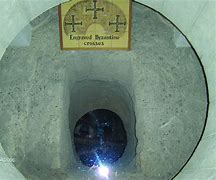 here, in this space, and in my mind's eye during my trip - in the totality of my raw emotional being - that I sought to shield Christ and to protect him from that descent. The dungeon is an earthly version of the very place we might call Hell, a place of darkness and malevolence. Whether Christ was actually ever there we do not know. It is tradition. I do know however, that I was mentally and emotionally transported into this space and found myself shouting his innocence at the tormenting beings residing there. Yet none listened, for how could they? I was millennia out of time and, even if I had not been, the enormity of my powerlessness in the face of such temporal power was absolute.
here, in this space, and in my mind's eye during my trip - in the totality of my raw emotional being - that I sought to shield Christ and to protect him from that descent. The dungeon is an earthly version of the very place we might call Hell, a place of darkness and malevolence. Whether Christ was actually ever there we do not know. It is tradition. I do know however, that I was mentally and emotionally transported into this space and found myself shouting his innocence at the tormenting beings residing there. Yet none listened, for how could they? I was millennia out of time and, even if I had not been, the enormity of my powerlessness in the face of such temporal power was absolute.
As I said earlier, part of my experience took place in the Garden of Gethsemane, which we had also visited earlier that year. Beside the Garden (which is all that is left of the ancient olive tree ghettos that once covered the entire hill), is the Church of All Nations, built over the rock on which Christ is believed to have prayed before his betrayal and arrest. Behind a fence of iron tracery stand the gnarled trunks of the few remaining olive trees, of considerable age and said to have been there for some 2,000 years because they replenish themselves. When my son and I were there it was impossible to feel anything approaching a spiritual atmosphere. Yet, in my mescaline experience I was transported to this place again – not visually - but emotionally. I went through a period of feeling total reassurance. I cannot begin to explain the incomparability of it. I knew - I was never told, but I knew - that I could not remain there. I had to come back. I was distraught at having to leave Christ's presence. The totality of God's acceptance of me, as conveyed by feelings, not words, were total. No judgement, just love - and acceptance of who and what I am. Unconditionally.
After only an hour – although it felt more like 3 or 4 hours as the passage of time was not the same - the effects of the mescaline began to wear off. A feeling of blissfulness came over me, in the sense that I felt relaxed and my heart was burning. My son sent a text to say he was disappointed that I had had no visualisations, even with my eyes closed. In his words I had not made “the breakthrough.” I postulated that perhaps the dosage was wrong, or the preparation, or that a liver condition inhibited the psychoactive element of the drug. Yet there is another possibility. I reminded him of our visit to the Church of the Holy Sepulchre, where I had become emotionally overwhelmed. It was, in fact, the same sensation and feeling I had experienced with the mescaline. How could this be? The Church of the Holy Sepulchre itself, including the resurrection tomb, had had no effect on me itself. The place is an eclectic mix of architecture and, with its unfriendly Orthodox clerics who manage the ‘ride' lines to sacred spaces, is little more than an ecclesiastical Disney. It was thronging with thousands of noisy and largely irreverent tourists, most of whom were there because it was on their bucket list. I felt nothing as I ascended the curving flight of stairs up the ‘hill' of Calvary.
Indeed, during my visit to Palestine I had hitherto felt no stirrings of a spiritual kind at all. It was too hot, too busy, too expensive, too rushed and sometimes too edgy for that. When I had entered the place of the baptism on the Jordan I had come out of the little river smelling of effluence, and truth be told that was where I thought much of the visit was on a spiritual level. Insofar as my Calvary experience is concerned, however, I had been pushed and jostled by tourists all day and here was no exception. I had been trying hard to keep my son and I together. Then it was our turn, and we briefly reached through and touched the cold rock of Calvary. Nothing - and again I emphasise neither was I anticipating anything. Then, however, as I walked away my heart began to feel differently and, gradually at first but then in quite a rush I was overcome with a sadness I cannot explain. It was involuntary, and made no particular sense, yet there I was, sobbing on my descent from the ‘hill.' I mention this because it was an identical burning sensation in my heart as that in my mescaline trip, only less intense. I can never know for sure, but I feel as if my experience of the mescaline, with the conceptualised Gethsemane and the cell at St Peter in Gallicantu, was somehow linked to what happened to me at the Holy Sepulchre. It was if they were waiting for the right conditions to come together; and the mescaline facilitated that, as if time itself no longer existed.
When I later came to reflect on all of this, in light of the observations I had made during that evening, I acknowledged that if I did get the mescaline dosage wrong, then I was glad. I had no need of anything more because, frankly, my interior journey taught me everything I needed to know. Secondly, my own limited experiences of visual and auditory manifestations in the past have invariably been unpleasant. Assuming them to be real and not hallucinatory, they can only have hailed from the lesser emanations. In a sense, the mescaline experience was unpleasant because of the grief and injustice I had felt at the treatment of Christ by his tormentors but, at the same time, it had been liberating and followed by a sense of deep absolution. It was a direct experience of the duality of good and evil, for sure, but the connection with God manifested as the direct via linea between the two. I more fully understand the allegory of the third pillar in Freemasonry, and my reflections since that evening have given me a better appreciation of the mysteries contained in Martinism. Thirdly, I do not regret my mescaline experience. I had feared that my true self, stripped down as it was to the core, would be exposed as bad, horrible or repugnant in some way, in other words how we often see ourselves and others in our daily lives. The opposite was in fact the case. To quote A. E. Waite, writing on Saint-Martin: “if the existence of sin among men be the consequence of a rebellion or misdirection of the will, it follows that their existing state of disorder is neither their true nor their first estate.” (The Life of Louis Claude de Saint-Martin, the Unknown Philosopher and the Substance of his Transcendental Doctrine).
If the sacrament provided me with a fleeting glimpse of even a fraction of my true or first estate, then I testify that there was nothing else I wanted nor anything else did I desire, than union with God.




